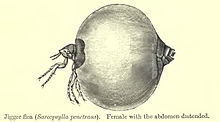
Tunga penetrans

Tunga penetrans (chigoe flea or jigger) is a parasitic insect found in most tropical and sub-tropical climates. It is native to Central and South America, and has been inadvertently introduced by humans to sub-Saharan Africa. Synonyms for Tunga penetrans include Sarcopsylla penetrans, Pulex penetrates, and many others. In its parasitic phase it has significant impact on its host, which include humans and certain other mammalian species. A parasitical infestation of T. penetrans is called tungiasis. T. penetrans is the smallest known flea, at only 1 mm. It is most recognizable in its parasite phase. While embedded under the stratum corneum layer of the skin, it may reach up to 1 cm across. During the first day or two of infestation, the host may feel an itching or irritation which then passes as the area around the flea calluses and becomes insensitive. As the flea's abdomen swells with eggs later in the cycle, the pressure from the swelling may press neighbouring nerves or blood vessels. Depending on the exact site, this can cause sensations ranging from mild irritation to serious discomfort. The colloquial name jigger may be confused with chigger, a parasitical mite. However, the jigger is of the order Siphonaptera as it is a flea. The chigger is a minute arachnid. Mites penetrate the skin and feed on skin cells that are broken down through an enzyme they secrete from their mouthparts, but they will then leave the host. The adult and the larval forms both feed on other animals. This is not the case with T. penetrans, as only the adults feed on mammals, and the mature female remains in the host for the rest of her life. T. penetrans is unusual for the 13 known species of the genus Tunga. First, it has a wide distribution: some 88 countries, in the Caribbean, Central and South America, tropical (sub-Saharan) Africa, and India.Second, It can infest a wide variety of hosts: at least 26 different species in over 5 different orders of mammals. In contrast, most of the 13 species of Tungidae are only in the Western hemisphere, and each only targets 1-2 specific warm-blooded hosts. Seven Tunga species infest only rodents. Two dedicate themselves to armadillos, one to sloths, and another prefers only cattle. Only one, Tunga trimamillata, has also been found infesting humans as well as cows, but only in Ecuador and Peru.
